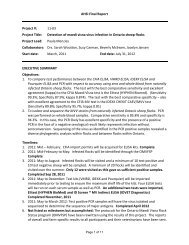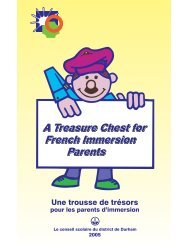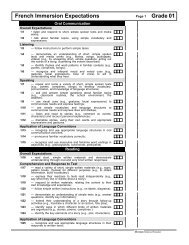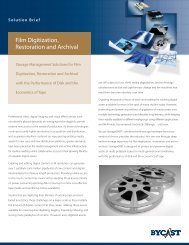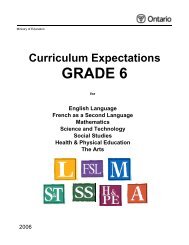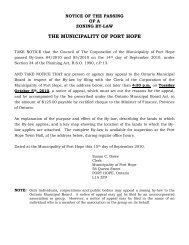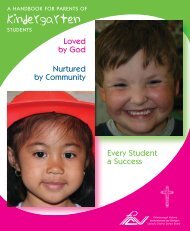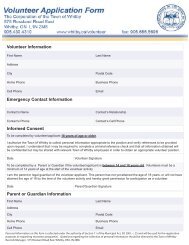GRADE 3 - PVNC Catholic District School Board
GRADE 3 - PVNC Catholic District School Board
GRADE 3 - PVNC Catholic District School Board
Create successful ePaper yourself
Turn your PDF publications into a flip-book with our unique Google optimized e-Paper software.
English Language Expectations<br />
Pg. 2<br />
3e10<br />
3e11<br />
Analysing Texts<br />
1.7 identify and explain the importance of significant ideas and information in oral texts (e.g., rank<br />
information in order of importance; compare key aspects of two oral texts using a Venn<br />
diagram; represent the main elements of an oral text on a web organizer or story map)<br />
Point of View<br />
1.8 identify the point of view in different types of oral texts and cite words, phrases, ideas, and<br />
information from the texts that confirm their identification (e.g., the use of first- or third-person<br />
personal pronouns in a narrative; the selective use of facts on a given topic; the use of words<br />
and phrases that indicate generalizations: all, every, always, never, every single time)<br />
Teacher prompts: “What helped you determine the point of view in this text?” “What evidence do you<br />
have that this is the speaker’s point of view?” ”Has the speaker used language that includes<br />
everyone?” “Is this point of view a common one in our world today?”<br />
3e12<br />
Presentation Strategies<br />
1.9 identify some of the presentation strategies used in oral texts and explain how they influence the<br />
audience (e.g., intonation, eye contact)<br />
Teacher prompts: “Do you think the speaker used intonation and eye contact in an appropriate and<br />
effective way? How did they influence your response?” “What other strategies might be effective in<br />
engaging or influencing the audience?”<br />
2. Speaking to Communicate<br />
3e13<br />
3e14<br />
3e15<br />
3e16<br />
3e17<br />
3e18<br />
Purpose<br />
2.1 identify a variety of purposes for speaking (e.g., to entertain an audience; to establish positive<br />
personal and learning relationships with peers; to ask questions or explore solutions to<br />
problems in smallgroup and paired activities; to explain to a small group how to play a new<br />
game; to present to the class an item or event of personal interest; to share ideas or<br />
information in order to contribute to understanding in large or small groups)<br />
Interactive Strategies<br />
2.2 demonstrate an understanding of appropriate speaking behaviour in a variety of situations,<br />
including smalland large-group discussions (e.g., paraphrase or restate other group members’<br />
contributions; acknowledge another person’s point of view; link their responses to the topic of<br />
conversation and/or what was said by the previous speaker)<br />
Clarity and Coherence<br />
2.3 communicate orally in a clear, coherent manner, presenting ideas, opinions, and information in a<br />
logical sequence (e.g., use an organizational pattern such as comparison or chronological<br />
order in presenting a short oral report)<br />
Appropriate Language<br />
2.4 choose a variety of appropriate words and phrases, including descriptive words and some technical<br />
vocabulary, and a few elements of style, to communicate their meaning accurately and engage the<br />
interest of their audience (e.g., use alliteration for emphasis; use comparatives such as like, instead<br />
of, however, the same as, compared to, unlike to clarify similarities and differences; use<br />
appropriate technical terms when explaining a scientific investigation)<br />
Vocal Skills and Strategies<br />
2.5 identify some vocal effects, including tone, pace, pitch, and volume, and use them appropriately,<br />
and with sensitivity towards cultural differences, to help communicate their meaning (e.g., pause<br />
in appropriate places long enough to allow others to respond during dialogue with peers or in<br />
small groups)<br />
Non-Verbal Cues<br />
2.6 identify some non-verbal cues, including facial expression, gestures, and eye contact, and use them<br />
in oral communications, appropriately and with sensitivity towards cultural differences, to help<br />
convey their meaning<br />
Ministry of Education 2006



